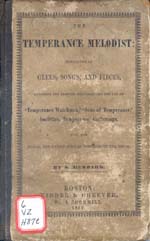
The Sons of Temperance Offering for 1850-51 … New York: Nafis & Cornish, [1849-50]. Special Collections & Archives, Wesleyan University.

Stephen Hubbard. The Temperance Melodist: Consisting of Glees, Songs, and Pieces, Arranged and Adapted … for the Use of … Societies, Temperance Gatherings … Boston: Kidder & Cheever, 1852. Price Hymnology Collection, Special Collections & Archives, Wesleyan University. Gift of Carl F. Price.
The spirit of reform that was so strong in the 1820s and 1830s extended beyond racial issues. The temperance movement, which promoted abstinence from alcohol, was also prominent. As American consumption of alcohol increased significantly at the turn of the 19th century, so did the reaction against its negative effects. With the founding of the American Temperance Society in 1826, the movement took off. Within five years, there were 2,220 temperance societies in the United States, with 170,000 members who had taken a pledge of abstinence. Much of the activity of temperance reformers was centered in churches of various denominations. The A.M.E. Zion church strongly supported temperance.


Timothy Shay Arthur. Temperance Tales, or, Six Nights with the Washingtonians. Philadelphia: W.A. Leary, [c1848]. Special Collections & Archives, Wesleyan University. This sensationalist temperance tale includes illustrations of the rapid decline of a man who takes to drink. Two of the seven scenes are reproduced here.

Charles Yale. The Temperance Reader, Designed for the Use of Schools. Boston: Hilliard, Gray, 1835. Special Collections & Archives, Wesleyan University. Gift of Jacob F. Huber.
Temperance was particularly popular in New England. Again, the Beman family was active in the cause. In 1833, Jehiel Beman founded the black Home Temperance Society of Middletown. He served as the organization’s president, while his son Leverett served as treasurer and Amos was secretary. Jehiel Beman was nearly as dedicated to temperance as he was to abolition. In 1836, he founded the Connecticut State Temperance Society of Colored People, and he later served as that organization’s president and general agent. In part because of the efforts of the Beman family, the temperance movement was especially strong among black people in Connecticut.


Middletown Temperance Union. [Manuscript record book]. Loaned by Middlesex County Historical Society. Note the names “L.C. Beman” (i.e., Jehiel Beman’s son Leverett), “H.A. Beman” (perhaps Jehiel Beman’s daughter Harriet), and I.B. Truitt, among the many signers of the temperance pledge.

R.E. Selden, Jr. An Address before the Middlesex Association, for the Promotion of Temperance … February 17th, 1829. Middletown, CT: Parmelee & Greenfield, [1829]. Middletown collection, Special Collections & Archives, Wesleyan University.

Connecticut Temperance Society. First Annual Report of the Executive Committee … May 19, 1830. Middletown, CT: W.D. Starr, 1830. Middletown collection, Special Collections & Archives, Wesleyan University.

William Dwight Franklin and the Continental Vocalists. Temperance revival ephemera, scrapbook of clippings and tickets, and photograph, [ca. 1854-1890]. William Dwight Franklin Collection, Special Collections & Archives, Wesleyan University.
William Dwight Franklin and the Continental Vocalists were a popular singing group based in the Middletown area. They traveled widely, performing as far away as Madison, Wisconsin. The Continental Vocalists sang regularly at temperance rallies, as well as giving many other types of concerts.





